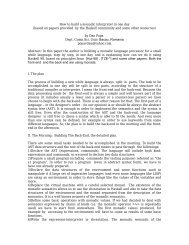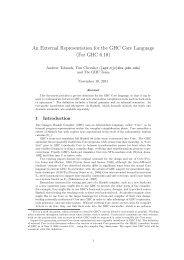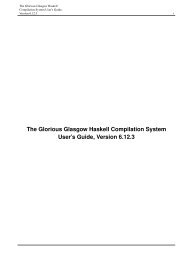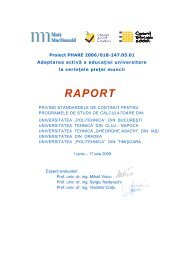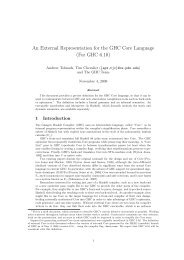Adaptable Software: How to build a modular monadic ... - Haskell
Adaptable Software: How to build a modular monadic ... - Haskell
Adaptable Software: How to build a modular monadic ... - Haskell
Create successful ePaper yourself
Turn your PDF publications into a flip-book with our unique Google optimized e-Paper software.
<strong>Adaptable</strong> <strong>Software</strong>: <strong>How</strong> <strong>to</strong> <strong>build</strong> a <strong>modular</strong> <strong>monadic</strong> extensible compiler<br />
using<br />
The State Monad and pseudoconstruc<strong>to</strong>rs over <strong>monadic</strong> values<br />
by Dan Popa<br />
“Vasile Alecsandri” Univ. of Bacău<br />
Abstract: The lazy evaluation mechanism included by the <strong>Haskell</strong> Language and the<br />
State Monad are used <strong>to</strong> <strong>build</strong> a <strong>modular</strong> plugin based compiler for a DSL called<br />
Simple. This is helping programmers <strong>to</strong> avoid the backpatching procedure, so<br />
producing a clear, <strong>modular</strong> simplified, <strong>monadic</strong> code genera<strong>to</strong>r.<br />
Keywords and phrases: the state monad, code layouts, <strong>modular</strong> trees and<br />
pseudoconstruc<strong>to</strong>rs over <strong>monadic</strong> values, AST's<br />
Introduction<br />
Three particular difficult tasks from the compiler <strong>build</strong>ing procedure are approached<br />
in this paper. The code genera<strong>to</strong>r we are writing here is intended <strong>to</strong> produce didactic<br />
code for the virtual machine described in [2].<br />
The three problems which are subjects of our investigation and implementation in<br />
<strong>Haskell</strong> are:<br />
1. The <strong>modular</strong> <strong>build</strong>ing of a compiler for a domain small language (DSL) which<br />
should be simple enough <strong>to</strong> be presented <strong>to</strong> the students from the faculties of<br />
Informatics or Computer Science. The task of language <strong>build</strong>ing is usually<br />
considered difficult by students, so the need of <strong>modular</strong>, clear, simplified<br />
implementations.<br />
2. To prove that pseudoconstruc<strong>to</strong>rs over <strong>monadic</strong> values defined and used by us<br />
in [4] are usable for adaptable <strong>modular</strong> compiler construction.<br />
3. The usage of the famous State Monad – which is described in [3] by Paul<br />
Hudak and colleagues as being an important piece of software for <strong>Haskell</strong><br />
programmers.<br />
Due <strong>to</strong> the lazy evaluation system of the <strong>Haskell</strong> language and it's interaction with<br />
the mutually recursive procedure of the code genera<strong>to</strong>r and the backpatching<br />
procedure wich is frequently involved in usual (C based) compilers, the problem of<br />
<strong>build</strong>ing code genera<strong>to</strong>rs for compilers in <strong>Haskell</strong> captured our interest. We intend <strong>to</strong><br />
show that backpatching procedure becomes obsolete and should not be<br />
implemented in <strong>Haskell</strong>, at all. The proof will be constructive, by effectively <strong>build</strong>ing<br />
a compiler.<br />
Also, due <strong>to</strong> the process of development by successive release of versions, which is<br />
implied by the languages construiction, the <strong>modular</strong> compilers are attracting<br />
researchers. It is a nice goal <strong>to</strong> <strong>build</strong> a compiler by simply putting <strong>to</strong>gether some<br />
Legolike pieces or modules and just compiling it in a single executable binary.<br />
The code genera<strong>to</strong>r will be shown in the next paragraphs, being incrementally <strong>build</strong>,<br />
Draft version, june – july 2011 v.09
and, we have <strong>to</strong> say, in a manner inspired by the book [2]. The code genera<strong>to</strong>r is<br />
suitable <strong>to</strong> be used in the backend of The Simple Language, or other imperative<br />
languages.<br />
Prerequisite<br />
The reader should be familiar with the Simple's Code Genera<strong>to</strong>r from [2] (Chap.7)<br />
and the idea of backpatching one of the challenges being <strong>to</strong> avoid the writing of the<br />
backpatch procedure by using the graphreduction mechanism in <strong>Haskell</strong>. It will<br />
demonstrate the posibilities of the lazyevaluation mechanism of the <strong>Haskell</strong><br />
implementation. As a result, the adresses wich are usually backpatched will be<br />
computed by need and at the right moment, by the <strong>Haskell</strong> program.<br />
Also, the reader should be familiar with the assembly languages as those one<br />
produced by this prettyprinting function (quoted below).<br />
The pretty printing procedure we are using here is accepting a term having the form<br />
of w<strong>to</strong> embraced pairs: ( (a,l), b) , where a is the length of the code, l is the list of<br />
instructions and b is the base address in the code segment.<br />
The prettyprinting function used by us is:<br />
PRETTY PRINTER prettyprint<br />
((a,l),b)<br />
= "\n" ++ "Length of the code:" ++<br />
show a ++ myprintl 0 l<br />
– 0, as base address can be replaced by b<br />
The myprint function is used <strong>to</strong> print the list of instructions, and is having the<br />
following definition.<br />
myprintl nr []<br />
= "\n" ++ show nr<br />
myprintl nr ((Instr a b) : l)<br />
= "\n" ++ show nr ++ "\t" ++<br />
a ++ show b ++ myprintl (nr+1) l<br />
It is using a basic (tail) recursion pattern <strong>to</strong> increment and transmitt the current<br />
address, noted as nr. As a result, such printing procedure will produce listings like<br />
the following (example).<br />
{ *MCOMP> mainA0<br />
Length of the code:9<br />
0 LD_INT 10<br />
1 LD_INT 20<br />
2 GT 0<br />
3 JZ 7<br />
Draft version, june – july 2011 v.09
4 LD_INT 45<br />
5 STORE 120<br />
6 JP 9<br />
7 LD_INT 50<br />
8 STORE 120<br />
9*MCOMP><br />
}<br />
The instructions (mnemonics and operands) of the assembly language used here are<br />
described, are implemented using a <strong>Haskell</strong> data declaration:<br />
INSTRUCTIONS data<br />
Instr a = Instr String a<br />
deriving (Show,Read,Eq)<br />
Each one of the elements of this type is having a name (for example “LD_INT”) and<br />
an argument, a. The type of a is left free. The instructions can be shown, read and<br />
compared for equality.<br />
The first monad we had used<br />
The pseudoconstruc<strong>to</strong>rs over <strong>monadic</strong> values introduced by us in [4] and used in<br />
[5]. They was defined <strong>to</strong> work with any monad, but due <strong>to</strong> the need of s<strong>to</strong>ring the<br />
current address as a state, we begun by using the state monad as presented in [3],<br />
(section 9.3.) having Int as the type of the states. The addresses in the machine code<br />
segment are, as usually, short integers, Int is, consequently, a good choice. So we<br />
had defined:<br />
type S = Int<br />
and had included the state monad by defining the statecapsules of state<br />
transformations as in:<br />
THE STATE MONAD data<br />
SM a = SM (S > (a,S))<br />
The SM datatype defined above is declared as instance of the state monad being<br />
supplied the common opera<strong>to</strong>rs as in section 9.3 of [3] .<br />
instance Monad SM where<br />
SM c1 >>= fc2 = SM (\st0 > let (r,st1) = c1 st0<br />
SM c2 = fc2 r<br />
in c2 st1 )<br />
return k = SM (\st > (k,st))<br />
Also, some basic <strong>monadic</strong> actions was defined:<br />
Draft version, june – july 2011 v.09
eadSM :: SM S<br />
readSM = SM (\s > (s,s))<br />
The above readSM action reads the current address from the state monad.<br />
updateSM :: (S > S) > SM S<br />
updateSM f = SM (\s > (s, f s))<br />
Despite the recommendation of updating the state we had widely used a WriteSM<br />
action which – inside the <strong>monadic</strong> capsule is acting as identity on it's first<br />
operand.<br />
writeSM :: S > SM S<br />
writeSM a = SM (\s > (s,a))<br />
allocSM :: S > SM S<br />
allocSM l = SM (\s > (s, s+l))<br />
runSM :: S > SM a > (a,S)<br />
runSM s0 (SM c) = c s0<br />
The runSM function is used, as usually, <strong>to</strong> trigger the computation in the state<br />
monad.<br />
The compiler<br />
As a consequence of the separation of the three components (or sets of components):<br />
– the (state) monad<br />
– the pretty printer<br />
– and, last but not least, the <strong>modular</strong> <strong>monadic</strong> entrypointless compilation rules<br />
we had defined,<br />
the whole compiler can now be written in a single,short, line:<br />
compile :: (Show t, Show t1) => SM (t, [Instr t1]) > IO ()<br />
compile arb = putStr . prettyprint $ runSM 0000 arb<br />
arb being the <strong>modular</strong> <strong>monadic</strong> syntax tree, built using pseudoconstruc<strong>to</strong>rs over<br />
<strong>monadic</strong> values, instead of regular data construc<strong>to</strong>rs<br />
Some practical remarks:<br />
The 0000 used above is the start address of the compilation process, so being the<br />
first address where the code will be generated. Of course, it can be changed or added<br />
as parameter of the compiler itself. Let's see how the compilation works and how the<br />
<strong>modular</strong> <strong>monadic</strong> entrypointless compilation rules of compilation was defined.<br />
Draft version, june – july 2011 v.09
Constant's compilation<br />
Compiling the constants has the simple effect of emitting a “LD_INT” code followed<br />
by the value of the constant. So the module of the compiler is:<br />
constant nr<br />
= do { a0 mainA1<br />
Length of the code:1<br />
0 LD_INT 10<br />
1<br />
*MCOMP><br />
Variable's compilation<br />
The compilation of the variables needs <strong>to</strong> use a symbol table, a mechanism able of<br />
identifying the location of each variable in the heap or the data segment. For our<br />
example, the following (dummy) function will be enough,<br />
symtable x = 000 + ord x<br />
because we intend <strong>to</strong> use 1 letter identifiers for variables and generate a short code,<br />
for tests only. For a long code, the 000 should be replaced by the base address in the<br />
used datasegment. The reader should feel free <strong>to</strong> change the code, here.<br />
Receiving the address of a variable from the symtable function, the compilation of a<br />
variable – as it is used in expressions – is <strong>modular</strong>ly described as:<br />
variable s<br />
= do { a0
}<br />
in do {<br />
writeSM a1;<br />
return (1, [Instr "LD_VAR " adr] )<br />
}<br />
So, running this simple action:<br />
mainB1 = compile (variable 'a')<br />
we have got this output:<br />
MCOMP> mainB1<br />
Length of the code:1<br />
0 LD_VAR 97<br />
1<br />
The code of the character will modify the offset of the variable in the data segment:<br />
mainB2 = compile (variable 'A')<br />
Running this action in the IO monad we have got:<br />
MCOMP> mainB2<br />
Length of the code:1<br />
0 LD_VAR 65<br />
1<br />
Data declarations<br />
If the declarations are compiled in the manner used in [2][Anthony A Aabey <br />
Compiler Construction Using Flex and Bison] and the code produced by a high level<br />
declaration is just a “DATA” instruction followed by the number of variables <strong>to</strong> be<br />
allocated on the stack. Then, in this case, the following module is usable:<br />
Compiling declarations<br />
nr – the number of successive monotyped variables<br />
being n variables n locations are allocated, counting from 0 <strong>to</strong> n1<br />
datas n<br />
= do { a0
e compiled as seen below:<br />
mainC1= compile (datas 10)<br />
Length of the code:1<br />
0 DATA 9<br />
1<br />
MCOMP><br />
Remark: our dummy symtable function is correlated with the use of an amount of<br />
space, which is reserved for all possible variables, not only for few. Of course, this<br />
module can be replaced with an other one, if needed.<br />
Compiling skip<br />
Inspiring by the previous rule, we can compile skip by producing no code at all. In<br />
this case the first attempt is:<br />
Compiling skip according with the previous model<br />
skip :: SM (Int,[Instr Int])<br />
skip<br />
= do { a0
Compiling I/O operations: the read statement<br />
note that read is just used, so we will note our module as “readv”<br />
readv s<br />
because the word “read” is in use<br />
= do { a0 <br />
Compiling I/O statements: the write command<br />
According <strong>to</strong> [2] compiling a write means <strong>to</strong> compile the expression which is<br />
following the write and adding a special instruction of the virtual machine. This is<br />
because of the presence of such an instruction, “OUT_INT” in the description of the<br />
virtual machine used there. In practice, different sort of codes or calls <strong>to</strong> the API of<br />
the operating system should be generated instead of this single instruction. (Note<br />
the unused operand, 0.) The module of the compiler will be:<br />
Compiling writings looks close <strong>to</strong> the compilation of assignments<br />
write exp<br />
= do { a0
Length of the code:2<br />
0 LD_VAR 120<br />
1 OUT_INT 0<br />
2<br />
Anticipating a bit, after the definition of the compilers modules which are<br />
responsible of arithmetic operations we can define:<br />
mainE2 = compile (write (plus (constant 10) (constant 20)) )<br />
And get this output:<br />
*MCOMP> mainE2<br />
Length of the code:4<br />
0 LD_INT 10<br />
1 LD_INT 20<br />
2 ADD 0<br />
3 OUT_INT 0<br />
4<br />
Assignment's compilation<br />
In [2] the layout of the code being generated when an assignment is compiled is<br />
composed by the code of the expression from the left side of the assignment followed<br />
by an instruction which is executed in order <strong>to</strong> s<strong>to</strong>re the result from the main<br />
(Accumula<strong>to</strong>r) register. This last instruction is having the s<strong>to</strong>rage address (which is<br />
the location of the variable) as operand. The address of the variable is provided – in<br />
this case – by the symtable function. The module of the compiler is:<br />
Compiling assignments<br />
attr s exp<br />
= do { a0
compilarea sumelor<br />
plus exp1 exp2<br />
= do { a0
(l3,cod3)
Length of the code:9<br />
0 LD_VAR 120<br />
1 LD_INT 0<br />
2 GT 0<br />
3 JZ 7<br />
4 LD_INT 1<br />
5 STORE 120<br />
6 JP 9<br />
7 LD_INT 2<br />
8 STORE 120<br />
9<br />
*MCOMP><br />
Also, the 120 appearing in the code is the location of the 'x' variable as it was<br />
provided by the symbol table's function, symtable.<br />
Sequence's compilation<br />
In this demonstrative module of the <strong>modular</strong> <strong>monadic</strong> compiler only two<br />
intermediate addreses should be saved and s<strong>to</strong>red in the state of the state monad.<br />
As a consequence, a simple let...in... <strong>Haskell</strong> expression can do the trick, and the<br />
module of the compiler is:<br />
Compiling sequences of two statements. Longest sequences can also be<br />
represented using a stair of such levels.<br />
The intermediate address, the first one after the first sequence of code should be<br />
saved in the state monad, in case that the second sequence is containing loops or<br />
conditionals.<br />
sequ s1 s2<br />
“seq” is used otherwise in <strong>Haskell</strong><br />
=do {a0
fact new levels of donotation are introduced (with all accompanying symbols). That<br />
is why the previous module dedicated <strong>to</strong> the compilation of conditionals had NOT<br />
used the let … in … expressions.<br />
Now, let's compile a sequence of two statements by defining and firing an action:<br />
mainW = compile (sequ (attr 'x' (constant 45)) (attr 'x' (constant 50)) )<br />
Starting the above action we have got this code:<br />
MCOMP> mainW<br />
Length of the code:4<br />
0 LD_INT 45<br />
1 STORE 120<br />
2 LD_INT 50<br />
3 STORE 120<br />
4<br />
*MCOMP><br />
So, this module is also functional.<br />
Compiling the While Loop<br />
The layout of the code producing when a while loop is compiled is containing only<br />
one (imbricated) major sequence of code, the corp of the loop. So, only one<br />
let...in..expression is used in this module of the compiler:<br />
while cond s1<br />
=do {a0
1 LD_INT 20<br />
2 GT 0<br />
3 JZ 7<br />
4 LD_INT 45<br />
5 STORE 120<br />
6 JP 0<br />
7<br />
MCOMP><br />
A more realistic example can be this one, a while loop decrementing it's counter:<br />
mainW1 = compile<br />
(while (gt (variable 'x') (constant 0))<br />
(attr 'x' (minus (variable 'x') (constant 1)) ))<br />
Producing:<br />
Length of the code:9<br />
0 LD_VAR 120<br />
1 LD_INT 0<br />
2 GT 0<br />
3 JZ 9<br />
4 LD_VAR 120<br />
5 LD_INT 1<br />
6 SUB 0<br />
7 STORE 120<br />
8 JP 0<br />
9<br />
MCOMP><br />
Compiling the dowhile loop<br />
An other kind of loop is the dowhile loop, also looping “around” a block of code –<br />
only one. So an other module of the compiler can be written, defining an other<br />
pseudoconstruc<strong>to</strong>r over <strong>monadic</strong> values:<br />
dowhile s1 cond<br />
= do { a0
The layout of the produced code is recognizable as argument of the <strong>monadic</strong> return<br />
opera<strong>to</strong>r, as usual in this paper. An action can be written, as ana example, <strong>to</strong>o see<br />
how dowhiles are compiled by this module:<br />
mainDW1 = compile<br />
(dowhile (attr 'x' (constant 45))<br />
(gt (constant 10) (constant 20) ) )<br />
And here is the machine code produced by running this action:<br />
*MCOMP> mainDW1<br />
Length of the code:6<br />
0 LD_INT 45<br />
1 STORE 120<br />
2 LD_INT 10<br />
3 LD_INT 20<br />
4 GT 0<br />
5 JNZ 0<br />
6<br />
MCOMP><br />
And here is a bigger, more realistic example:<br />
mainDW2 = compile<br />
(dowhile (attr 'x' (minus (variable 'x') (constant 1)) )<br />
(gt (variable 'x') (constant 0)) )<br />
This tree <strong>build</strong> with pseudoconstruc<strong>to</strong>rs is in fact the tree of a statement which<br />
looks similarly with: do { x = x 1 ; } while x > 0 . And here is the code:<br />
Length of the code:8<br />
0 LD_VAR 120<br />
1 LD_INT 1<br />
2 SUB 0<br />
3 STORE 120<br />
4 LD_VAR 120<br />
5 LD_INT 0<br />
6 GT 0<br />
7 JNZ 0<br />
8<br />
*MCOMP><br />
Conclusion<br />
At this point, a set of conclusions can be drawn, the important, in our opinion are:<br />
1. The backpatching procedure can be successfully removed from the compiler,<br />
it's place being taken by the au<strong>to</strong>matic graphreduction procedure which is<br />
included in the lazyevaluation mechanism of the <strong>Haskell</strong> language. The<br />
programmer should not worry about it, nowadays. As the reader had noticed<br />
by absence, the backpatching procedure is not necessary anymore when using<br />
Draft version, june – july 2011 v.09
a language like <strong>Haskell</strong> for compiler construction.<br />
2. The idea of using data types a la carte as presented by Wouter Swierstra, was<br />
not used by us, leading <strong>to</strong> a simple, clear, solution.<br />
3. In fact, pseudoconstruc<strong>to</strong>rs over <strong>monadic</strong> values are assuring us a simple and<br />
flexible environment. This is why his paper is not cited as reference, here.<br />
Modular <strong>monadic</strong> compilers, horizontally sliced in portions containing a<br />
<strong>modular</strong> <strong>monadic</strong> parser, a <strong>modular</strong> <strong>monadic</strong> typechecker , and this above<br />
described, <strong>modular</strong> code genera<strong>to</strong>rs can be built (around pseudoconstruc<strong>to</strong>rs<br />
over <strong>monadic</strong> values,) having <strong>modular</strong> trees built on pseudoconstruc<strong>to</strong>rs over<br />
<strong>monadic</strong> values as internal representations of ASTs.<br />
4. No explicit func<strong>to</strong>rs are used – even if implicit func<strong>to</strong>rs and categories are<br />
involved in the compilation process. This makes a compiler design which is<br />
suitable for both students and programmers,<strong>to</strong>o.<br />
5. The compiler is <strong>modular</strong>ly extensible, being a collections of descriptions which<br />
can be all placed in different modules, imported and compiled <strong>to</strong>gether with a<br />
small main program. Modules are reusable. The replacement of usual tree<br />
declarations with pseudoconstruc<strong>to</strong>rs over <strong>monadic</strong> values eliminates the need<br />
of backreediting the tree's declarations, and also eliminates the dependence<br />
between modules and that AST's declarations.<br />
6. This design can be developed, still remaining based on this notions the state<br />
monad, code layouts, <strong>modular</strong> trees and pseudoconstruc<strong>to</strong>rs over <strong>monadic</strong><br />
values. More layouts of code can be found in classic books on compiler<br />
constructions, like [1]. Speed can be improved, using functional composition.<br />
This should be investigated. The code of the compiler and also some different<br />
but related approaches are available from [6].<br />
References<br />
[1] Alfred V. Aho, Monica S. Lam, Rav Sethi, Jeffrey D. Ulman, Compilers Principles<br />
Techniques And Tools Second Edition , Addison Wesley, Pearson Education, 2007<br />
[2] Anthony A Aabey Compiler Construction Using Flex and Bison, Walla Walla<br />
College, Version of February 25, 2004<br />
[3] Paul Hudak, Joseph H Fasel (et.co.) A gentle introduction <strong>to</strong> <strong>Haskell</strong>. ACM<br />
SIGPLAN Notices, 27(5), May 1992. Also available as Research Report<br />
YALEU/DCS/RR901, Yale University, Department of Computer Science, April 1992.<br />
[4] Dan Popa – Direct <strong>modular</strong> evaluation of expressions using the monads and type<br />
classes in <strong>Haskell</strong>, STUDII ŞI CERCETĂRI ŞTIINŢIFICE Seria: MATEMATICĂ ,<br />
UNIVERSITATEA DIN BACĂU, Nr. 18 (2008), pag. 233 – 248<br />
[5] Dan Popa <strong>Adaptable</strong> <strong>Software</strong> – Modular extensible <strong>monadic</strong> evalua<strong>to</strong>r and<br />
typechecker based on pseudoconstruc<strong>to</strong>rs, ARA Congress: ARA35 – SCIENCE & ART<br />
IN THE INFORMATICS’ ERA, 610 Jully 2011, ”POLITEHNICA” University of<br />
Timisoara<br />
[6] Dan Popa Modular_Monadic_Compilers_for_Programming_Languages<br />
http://www.haskell.org/haskellwiki/Modular_Monadic_Compilers_for_Programming<br />
_Languages<br />
Draft version, june – july 2011 v.09
Appendix A<br />
The module of the compiler which is responible of the compilation of the “>”<br />
comparation opera<strong>to</strong>r is presented below, in case the reader needs it.<br />
gt exp1 exp2<br />
= do{a0
variables the produced code have the same layout.<br />
*MCOMP> main4<br />
Length of the code:22<br />
0 DATA 1<br />
1 IN_INT 110<br />
2 LD_VAR 110<br />
3 LD_INT 10<br />
4 LT 0<br />
5 JZ 9<br />
6 LD_INT 1<br />
7 STORE 120<br />
8 JP 9<br />
9 LD_VAR 110<br />
10 LD_INT 10<br />
11 LT 0<br />
12 JZ 22<br />
13 LD_INT 5<br />
14 LD_VAR 120<br />
15 MULT 0<br />
16 STORE 120<br />
17 LD_VAR 110<br />
18 LD_INT 1<br />
19 ADD 0<br />
20 STORE 110<br />
21 JP 9<br />
22*MCOMP><br />
The original example from [2] can be found in Figure 7.2, page 35 in the 2004<br />
edition, and compared with the above code.<br />
Draft version, june – july 2011 v.09




